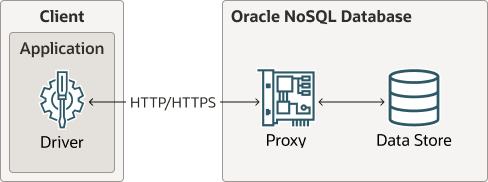Using the Proxy in a non-secure data store
Starting up the Proxy
Use the following command to start up the proxy for a non-secure data store.
java -jar lib/httpproxy.jar \
-storeName <kvstore_name> \
-helperHosts <kvstore_helper_host> \
[-hostname <proxy_host>] \
[-httpPort <proxy_http_port>] kvstore_nameis the data store name obtained from the data store deployment. See ping.kvstore_helper_hostis the data store's helper host:port list obtained from the data store deployment. See Obtaining a KVStore Handle in the Java Direct Driver Developer's Guide.proxy_hostis the hostname of the machine to host the proxy service. This parameter is optional and defaults tolocalhost. You can also specify the complete hostname of the machine running the proxy.proxy_http_portis the port on which the proxy is listening for requests. This is an optional parameter and defaults to 80.Note:
Using port 80 requires root privilege. You can use port 8080 if you do not have root privilege.
Connecting an application to the non-secure data store

Description of the illustration proxy_arch.png
Oracle NoSQL Database drivers are available in various programming languages that are used in the client application. Currently, Java, Python, Go, Node.js, C# are supported. Oracle NoSQL Database Proxy is a server that accepts requests from the client application and processes them using the Oracle NoSQL Database.
The Oracle NoSQL Database Java Driver contains the jar files that enable a Java application to communicate with the proxy.
Install the Java driver in the application's classpath and use the following code to connect to the proxy.
String endpoint = "http://<proxy_host>:<proxy_http_port>";
StoreAccessTokenProvider atProvider = new StoreAccessTokenProvider();
NoSQLHandleConfig config = new NoSQLHandleConfig(endpoint);
config.setAuthorizationProvider(atProvider);
NoSQLHandle handle = NoSQLHandleFactory.createNoSQLHandle(config); where,
proxy_hostis the hostname of the machine running the proxy service. This should match the host you configured earlier.proxy_http_portis the port on which the proxy is listening for requests. This should match the http port you configured earlier.
The on-premises configuration requires a running instance of the Oracle NoSQL database. In addition a running proxy service is required.
borneo.kv.StoreAccessTokenProvider is used. For
example:from borneo import NoSQLHandle, NoSQLHandleConfig
from borneo.kv import StoreAccessTokenProvider
endpoint = 'http://<proxy_host>:<proxy_http_port>'
# Create the AuthorizationProvider for a not secure store:
ap = StoreAccessTokenProvider()
# create a configuration object
config = NoSQLHandleConfig(endpoint).set_authorization_provider(ap)
# create a handle from the configuration object
handle = NoSQLHandle(config)proxy_hostis the hostname of the machine running the proxy service. This should match the host you configured earlier.proxy_http_portis the port on which the proxy is listening for requests. This should match the http port you configured earlier.
The on-premises configuration requires a running instance of the
Oracle NoSQL database. In addition a running proxy service is required. In this
case, the Endpoint config parameter should point to the NoSQL
proxy host and port location.
...cfg:= nosqldb.Config{
// EDIT: set desired endpoint for the Proxy server accordingly in your environment.
Endpoint: "http:<proxy_host>:<proxy_http_port>",
Mode: "onprem",
}
client, err:=nosqldb.NewClient(cfg)
iferr!=nil {
fmt.Printf("failed to create a NoSQL client: %v\n", err)
return
}
deferclient.Close()
// Perform database operations using client APIs.// ...proxy_hostis the hostname of the machine running the proxy service. This should match the host you configured earlier.proxy_http_portis the port on which the proxy is listening for requests. This should match the http port you configured earlier.
Your application will connect and use a running NoSQL database via the proxy service.
In non-secure mode, the driver communicates with the proxy via the HTTP protocol.
The only information required is the communication endpoint.
For on-premise NoSQL Database, the endpoint specifies the url of the proxy, in
the form http://proxy_host:proxy_http_port
const NoSQLClient = require('oracle-nosqldb').NoSQLClient;
const ServiceType = require('oracle-nosqldb').ServiceType;
const client = new NoSQLClient({
serviceType: ServiceType.KVSTORE,
endpoint: '<proxy_host>:<proxy_http_port>'
});proxy_hostis the hostname of the machine running the proxy service. This should match the host you configured earlier.proxy_http_portis the port on which the proxy is listening for requests. This should match the http port you configured earlier.
{
"serviceType": "KVSTORE",
"endpoint": "<proxy_host>:<proxy_http_port>",
}
const NoSQLClient = require('oracle-nosqldb').NoSQLClient;
const client = new NoSQLClient('</path/to/config.json>');Your application will connect and use a running NoSQL database via the proxy service.
In non-secure mode, the driver communicates with the proxy via the HTTP protocol.
The only information required is the communication endpoint.
For on-premise NoSQL Database, the endpoint specifies the url of the proxy, in
the form http://proxy_host:proxy_http_port
ServiceType.KVStore. You can provide an instance of
NoSQLConfig either directly or in a JSON configuration
file.var client = new NoSQLClient(
new NoSQLConfig
{
ServiceType = ServiceType.KVStore,
Endpoint = "<proxy_host>:<proxy_http_port>"
});
proxy_hostis the hostname of the machine running the proxy service. This should match the host you configured earlier.proxy_http_portis the port on which the proxy is listening for requests. This should match the http port you configured earlier.
{
"ServiceType": "KVStore",
"Endpoint": "<proxy_host>:<proxy_http_port>"
}var client = new NoSQLClient("</path/to/config.json>");